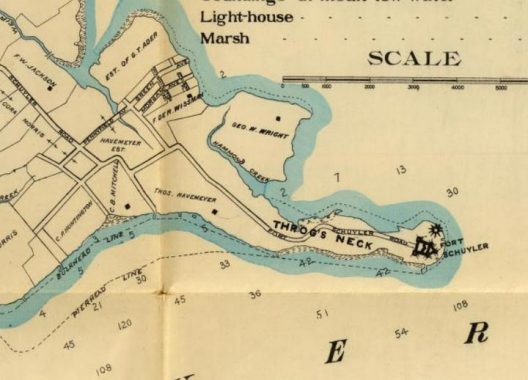I hadn’t noticed this faux arrowhead Triborough Bridge and Tunnel Authority sign at Sanford Avenue and 162nd Street in Flushing, pointing the way to Throgs Neck. Traffic headed there would likely take Sanford to Northern Boulevard, then take the Clearview Expressway across the Throgs Neck Bridge. Signs of this type used by be cut in the shape of actual arrowheads; modern ones depict them on standard rectangular signs.
One interesting aspect of Throgs Neck is that there is a spelling variation with two G’s, Throggs.
Throgs Neck, the mainland Bronx’ most southeastern redoubt, was named for a very early British settler, John Throckmorton, who arrived in the peninsula now capped by Fort Schuyler in 1642. Throckmorton had had religious differences with the rigid Puritans of New England, moved to Rhode Island with its founder, Roger Williams in 1636, and later decamped to the Bronx because he may have feared that Massachusetts would invade the tiny colony. Both Thomas Pell, who owned much of the northeast Bronx in the colonial era, and Throckmorton had to pledge allegiance to the Dutch crown before being granted permission to settle. Throckmorton later fled Native American aggression and wound up in Rhode Island again and later, New Jersey.
The peninsula, or “neck” (cf. Little Neck in Queens) was bestowed an abbreviation of his lengthy name and the neighborhood’s Throgmorton Avenue, also a tribute, is a variant spelling. Throgs Neck is also occasionally spelled with a double g. The explanation for all this may lie in the fact that in the early days of printing (which in Throckmorton’s day had been an industry for only about a century and a half) spellings were hardly standardized, and wouldn’t be until the days of Samuel Johnson and Noah Webster. Indeed some maps even have it as Frogs’ Neck, which is what I thought it was when I first heard the name of the Bridge as a kid. However Throgs Neck is spelled, it is a peaceful, tranquil area with a couple of private communities that enjoy terrific views of the water-filled surroundings.

Why are there variant spellings? The common story that you read and hear about is that it was Throggs Neck all along, until Robert Moses and the TBTA built the bridge from 1959-1962 and discarded one of the G’s to save a few bucks on the road signage. To me, it couldn’t be as cut and dried as all that. For example, this 1900 Hyde atlas excerpt shows the area as Throg’s Neck, with one G and an apostrophe. My thinking is that the two spellings coexisted all along. Today, most Throg(g)s Neckers spell it with two G’s, while everyone else gets by with one.
It’s not unprecedented that the road signage can change. An extra Z was added to the Verrazzano-Narrows Bridge after a decades-long lobbying campaign that insisted Giovanni da Verrazzano used two Z’s in his name. In reality, scribes of the time used multiple spellings on proper names and other words on the same page. It wasn’t till much later that standard spellings were used.
Check out the ForgottenBook, take a look at the gift shop, and as always, “comment…as you see fit.”
7/10/19
